Physical Address
304 North Cardinal St.
Dorchester Center, MA 02124
Physical Address
304 North Cardinal St.
Dorchester Center, MA 02124
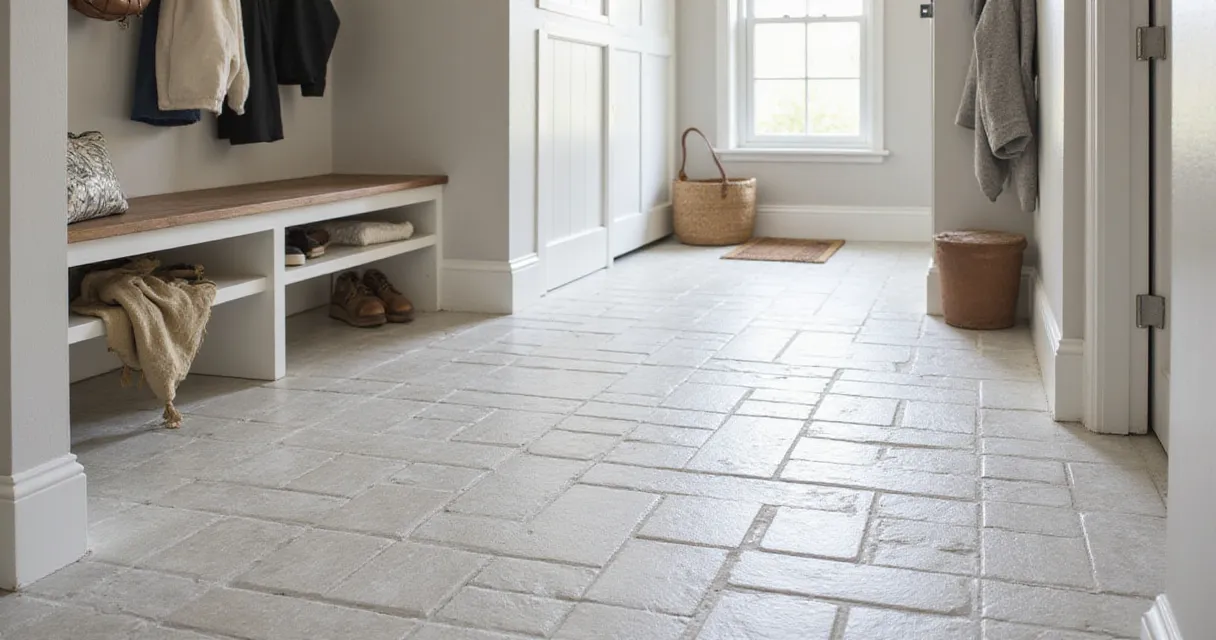
Discover 21 durable and stylish mudroom flooring ideas that combine practicality with design. From waterproof options to budget-friendly solutions, find the perfect foundation for your high-traffic entryway.
Stepping into your home should be a breath of fresh air, a transition from the chaotic outside world to your Personal Sanctuary. But for many, the entryway – often known as the mudroom – becomes a battleground against dirt, grime, and clutter. Shoes pile up, coats overflow, and the floor… oh, the floor! It bears the brunt of every outdoor adventure, every rainy day dash, and every hurried school drop-off.
What if your mudroom could be both functional and beautiful? What if your flooring could withstand the daily onslaught while also setting the stage for a stylish and organized home? It’s time to ditch the drab and embrace the fab! Get ready to discover 21 mudroom flooring ideas that will not only conquer the chaos but also welcome you home in style.
Porcelain tile earns its reputation as the ultimate mudroom flooring champion through an intense firing process at incredibly high temperatures. This extreme heat creates a remarkably dense, hard, and virtually non-porous material that shrugs off scratches from scooting boots, resists stubborn stains from muddy footprints, and laughs in the face of water damage from snow-covered gear. Its non-porous nature actively prevents the growth of mold and mildew, which thrive in damp environments.

For the highest performing mudroom floor, consider through-body porcelain where the color permeates the entire tile, making scratches virtually disappear. Glazed porcelain offers an extra layer of defense against stains and moisture, while textured finishes significantly improve slip resistance – a critical safety factor in a space prone to wetness. For a modern, streamlined look with minimal maintenance, Large Format Porcelain Tiles are fantastic, though professional installation is generally recommended due to their size and weight.
Here’s where it gets interesting… while porcelain tile brings unmatched durability to your mudroom, some homeowners crave the warmth of wood without the worry of water damage.
Dreaming of classic wood beauty in your mudroom but concerned about moisture damage? Luxury Vinyl Plank (LVP) delivers the perfect compromise. This innovative flooring artfully mimics real wood while providing exceptional water resistance and durability. Unlike genuine hardwood, LVP is completely impervious to water, eliminating worries about warping, staining, or rot from wet shoes and melting snow.
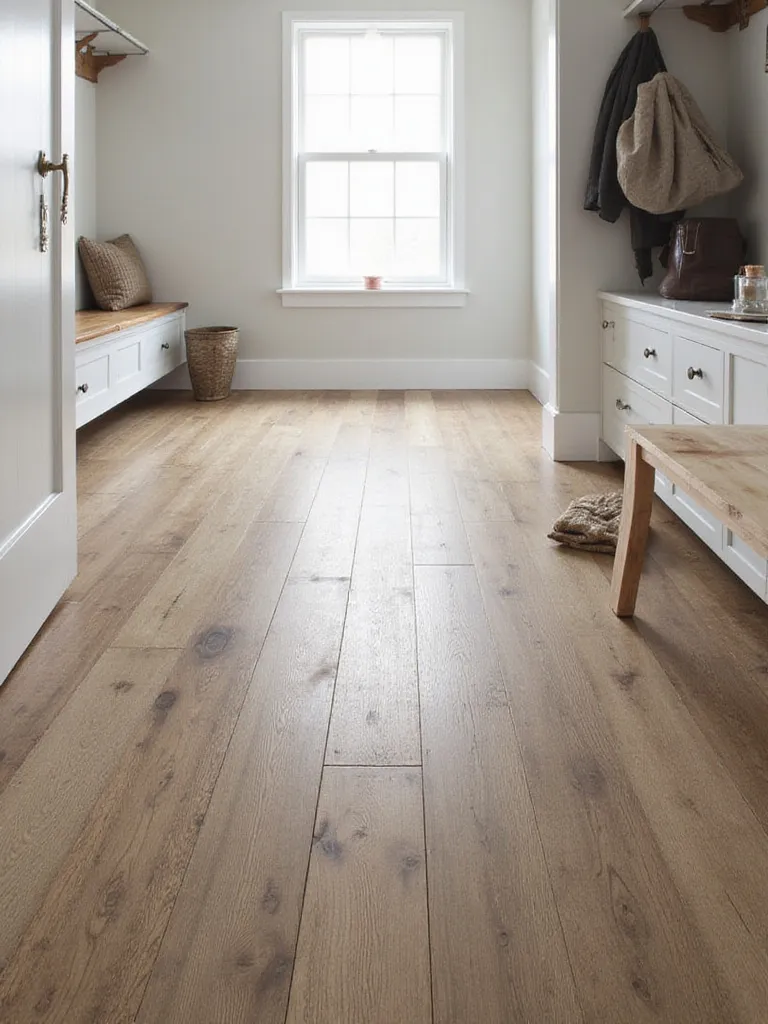
For mudrooms, prioritize thicker planks – at least 5mm – with a robust wear layer of 20 mil or higher. The wear layer, that transparent top coating, is your primary defense against scratches and scuffs. Choose between glue-down LVP for permanent stability in moisture-prone areas, or click-lock (floating) systems for easier DIY installation. Rigid core options like SPC (Stone Polymer Composite) or WPC (Wood Polymer Composite) offer enhanced stability against temperature fluctuations – a great benefit in mudrooms that experience varying conditions.
The surprising part is that while LVP brings practical warmth to your mudroom, some homeowners seek the timeless elegance and enduring strength that only natural materials can provide.
For those craving sophisticated durability, natural stone tile transforms a mudroom from purely functional to genuinely breathtaking. Slate stands out for its inherent slip resistance and rich color variations, bringing rustic charm that hides dirt beautifully. Travertine offers warm, earthy tones with a more refined look, though it requires regular sealing. Limestone presents similar aesthetics but may be slightly less porous. Granite, renowned for its exceptional hardness, resists stains masterfully – perfect for high-traffic areas. For truly unique character, flagstone’s irregular shapes create an organic, rugged aesthetic that’s impossible to replicate.

While natural stone brings undeniable beauty, it’s worth weighing its practical considerations. The advantages include exceptional longevity, timeless appeal that elevates your home’s value, and unique character in every tile. However, costs run significantly higher than many alternatives. Most natural stones require regular sealing every 1-3 years to prevent staining, particularly travertine and limestone. Some polished stones become slippery when wet, making textured or honed finishes essential for mudroom safety. Installation complexity often requires professional expertise, adding to your investment.
The key thing to understand is that while natural stone delivers unmatched elegance, budget-conscious homeowners have excellent water-resistant options that won’t break the bank.
For practical homeowners watching their renovation dollars, sheet vinyl emerges as a compelling mudroom flooring contender. Its most significant advantage? Affordability without sacrificing functionality. Beyond cost-effectiveness, sheet vinyl is inherently water-resistant – crucial in spaces where moisture constantly threatens. Its seamless, roll-out installation minimizes seams where water might penetrate to damage subfloors. Cleaning requires only regular sweeping and occasional mopping, while modern manufacturing techniques have dramatically improved style options to complement various design aesthetics.
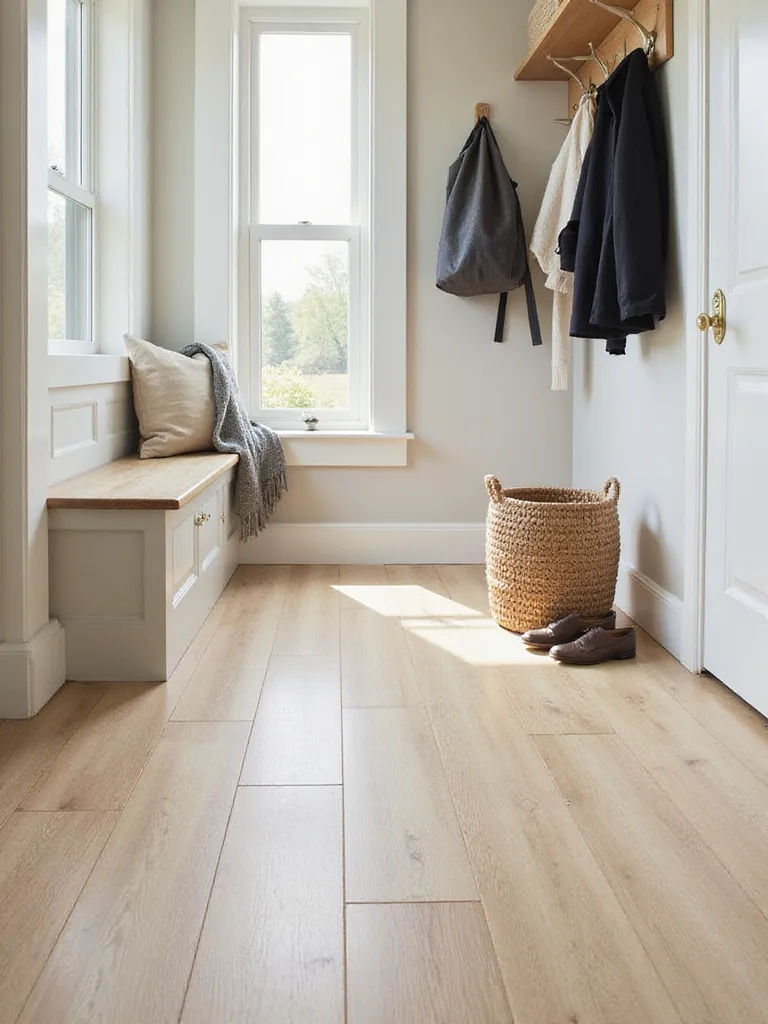
When selecting sheet vinyl for mudroom durability, thickness matters – particularly the wear layer. For high-traffic mudrooms, opt for sheet vinyl with a wear layer of 12 mil or higher to enhance resistance against scratches, scuffs, and tears from heavy foot traffic, pet claws, and dropped items. While the initial cost savings might tempt you toward budget options, investing in higher-quality sheet vinyl significantly improves longevity and overall value, often proving more economical over time.
What complicates this is that some homeowners desire industrial chic aesthetics with unmatched durability – which leads us to an unexpected mudroom flooring contender.
If modern industrial aesthetics and unwavering durability top your mudroom flooring priorities, concrete deserves serious consideration. This material stands up to daily abuse from heavy foot traffic, tracked-in dirt, and persistent moisture without flinching. Its resilience makes it perfect for busy mudrooms under constant assault. Maintenance couldn’t be simpler – regular sweeping and occasional damp mopping keep concrete looking its best. Beyond practicality, concrete delivers sleek, contemporary vibes that can be customized through various finishes, stains, and colors to match your personal style. It’s surprisingly cost-effective, especially if your home already has a concrete slab subfloor.

Concrete flooring offers remarkable versatility through different finishes. Polished concrete creates ultra-modern, high-gloss surfaces that clean easily but may become slippery when wet. Sealed concrete provides a simpler, budget-friendly option where concrete is stained or left natural then sealed for protection. Stained concrete unlocks endless color possibilities and custom patterns. Epoxy coating creates highly durable, seamless, waterproof surfaces in countless colors, though at higher cost. Stamped concrete can mimic tile or stone with customizable texture, though cleaning becomes slightly more involved.
The breakthrough came when homeowners discovered that rustic charm and enduring strength could coexist beautifully in mudroom flooring – through the timeless appeal of brick pavers.
For a mudroom floor radiating rustic warmth and impressive durability, brick pavers deliver undeniable character. These remarkably tough surfaces withstand heavy foot traffic, water, mud, and dirt – all mudroom constants. Their naturally textured surface provides inherent slip resistance, crucial for moisture-prone areas. Beyond practicality, brick pavers bring cozy, inviting warmth that beautifully contrasts with utilitarian mudroom functions. Their natural color variations cleverly camouflage dirt and minor imperfections, reducing maintenance headaches.
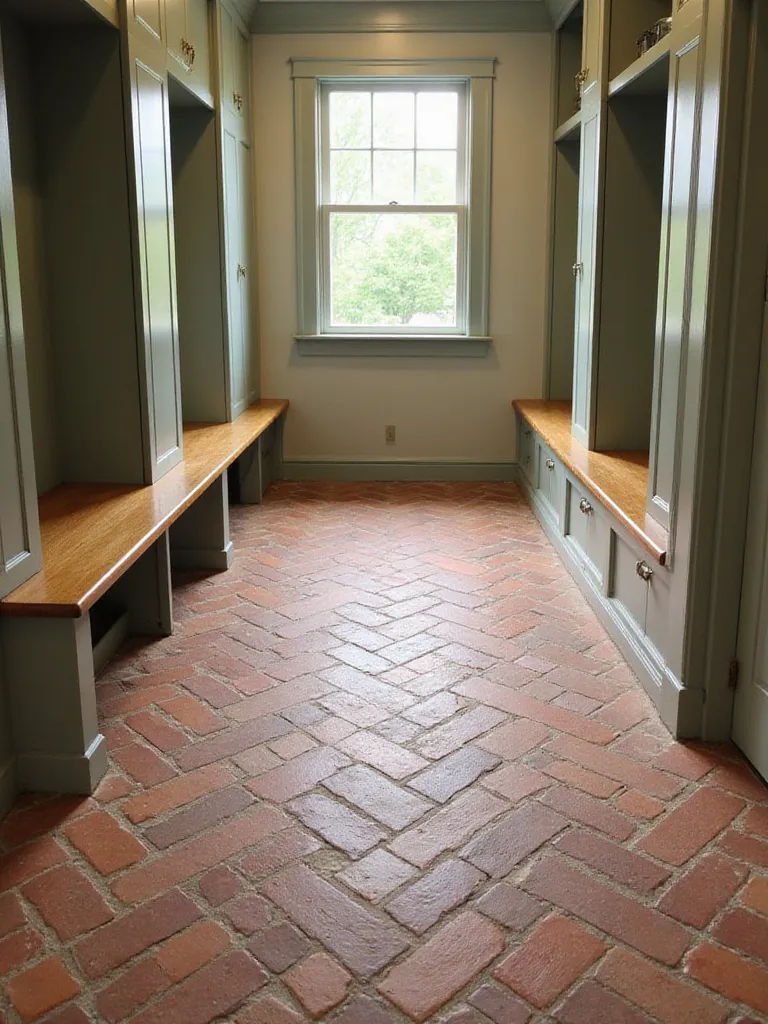
When exploring brick paver options, you’ll discover distinct varieties with unique characteristics. Clay pavers offer timeless appeal and exceptional durability, representing traditional brick aesthetics. Concrete pavers provide budget-friendly alternatives in countless colors and styles that convincingly mimic genuine brick. Reclaimed brick pavers bring weathered character and sustainability, adding history and eco-consciousness to your design – though they may require more thorough cleaning and sealing due to previous exposure. Your choice ultimately depends on material preferences, color options, texture desires, and budget constraints.
Let me paint you a picture… while brick brings rustic charm, families with young children or seniors might prioritize safety and comfort above all else in their mudroom flooring.
In family-focused homes where safety takes precedence, rubber flooring transforms mudrooms into forgiving sanctuaries. Its soft, cushioned surface provides safe landings for everyone, especially important when entering with wet or muddy shoes. This shock-absorbing quality makes rubber remarkably comfortable for extended standing – perfect when managing after-school gear, sorting packages, or helping little ones with outerwear. Rubber’s exceptional durability resists scratches, dents, and scuffs brilliantly, while its easy-clean nature means spills, mud, and dirt wipe away effortlessly – maintaining a hygienic space with minimal effort.

Rubber flooring comes in several forms to suit different needs. Rubber rolls offer seamless coverage across large areas, minimizing water seepage risks while creating uniform looks, though installation can be complex. Rubber tiles provide easier DIY installation through interlocking or adhesive systems, allowing customized designs and simple replacement of damaged sections. Recycled rubber, made from tires and other rubber products, offers eco-conscious cushioning at lower costs, though it may initially have a distinct odor. Virgin rubber brings wider color options and less odor but costs more and lacks environmental benefits.
Think of it as… while rubber delivers unmatched safety, some homeowners desire stylish looks on tight budgets and are willing to be diligent about maintenance. For them, laminate offers an interesting alternative.
For style-conscious homeowners working with limited renovation funds, laminate flooring presents a compelling mudroom option. Its budget-friendly price point sits significantly below tile, hardwood, or stone, making beautiful floors accessible for cost-conscious projects. Laminate’s remarkable range of aesthetics convincingly mimics expensive materials like hardwood, stone, and tile without premium costs. Installation proves DIY-friendly, especially click-lock systems, further reducing project expenses. Cleaning requires only simple sweeping and damp mopping – perfect for busy mudrooms. However, choosing laminate specifically designed for enhanced moisture resistance is absolutely critical for mudroom applications.

When selecting laminate for mudrooms, certain considerations become non-negotiable. Water resistance tops the list – prioritize products explicitly labeled waterproof or water-resistant. The AC (Abrasion Class) rating indicates durability; choose AC3 or AC4 for better scratch, dent, and wear resistance. Thicker planks generally offer improved stability and impact resistance. Proper installation prevents moisture problems and warping; always use vapor barrier underlayment to protect laminate from subfloor moisture migration.
You might be wondering… what if you crave real wood’s beauty but need enhanced moisture protection? Engineered hardwood offers an elegant compromise for your mudroom flooring.
Captivated by hardwood’s timeless elegance but concerned about mudroom moisture? Engineered hardwood delivers authentic beauty with improved performance. Unlike solid hardwood’s single-piece construction, engineered hardwood features genuine wood veneer bonded to multiple plywood or HDF core layers. This clever design significantly reduces expansion and contraction from humidity fluctuations that cause solid hardwood’s warping, cupping, and gapping – particularly problematic in mudrooms. The result? Real wood beauty with substantially better moisture tolerance.

While engineered hardwood handles occasional spills better than solid hardwood when promptly cleaned, it’s important to understand it’s not waterproof. Standing water will eventually cause damage. Moisture resistance varies significantly based on core material quality and protective finish. For mudroom applications, prioritize products with thicker veneer layers and high-quality, moisture-resistant finishes. Some premium engineered hardwood now features waterproof cores, though at higher price points. This combination of beauty and improved performance makes engineered hardwood a compelling mudroom flooring option for those unwilling to sacrifice wood’s warmth.
The heart of the matter is that while engineered hardwood brings real wood warmth with improved moisture resistance, some homeowners prefer the proven reliability of ceramic tile for their mudroom flooring.
For mudroom flooring that combines timeless appeal with proven performance, ceramic tile remains an enduring favorite. Its exceptional practicality has made it a go-to material for generations of homeowners. Ceramic tile withstands daily abuse in high-traffic entryways without complaint. Its inherent water resistance shrugs off moisture from wet shoes, snowy boots, and inevitable spills. Cleaning couldn’t be simpler – its non-porous surface allows mud, snow, and spills to wipe away effortlessly. All this comes at remarkably reasonable cost compared to many alternatives, delivering long-term value without breaking renovation budgets.

When selecting ceramic tile for mudrooms, understanding different types helps match performance to your needs. Glazed ceramic tile, the most common variety, offers superior water and stain resistance through its protective surface layer. For mudrooms, choose tiles with PEI (Porcelain Enamel Institute) ratings of 3 or higher to ensure adequate abrasion resistance. Unglazed ceramic can work for mudrooms if manufactured specifically for high-traffic areas and treated for stain resistance, offering more natural, rustic aesthetics. Porcelain tile, technically a ceramic subcategory, provides even greater density and water resistance – particularly valuable in regions with harsh winters and significant moisture exposure.
Let me show you another perspective… beyond classic ceramic, modern design trends favor large format tiles that minimize grout lines and create cleaner, more spacious looks.
Modern mudroom design increasingly embraces large format tiles for their practical and aesthetic advantages. Their primary appeal? Dramatically reduced grout lines. This seemingly simple feature delivers outsized benefits – fewer grout lines means significantly less scrubbing, as there are fewer places where dirt, grime, and moisture accumulate. Cleaning becomes noticeably faster and more effective. Visually, large format tiles create cleaner, more expansive looks that make even modest mudrooms feel less cluttered and more open. The reduced grout also means less long-term maintenance, with fewer opportunities for cracking, staining, or discoloration – particularly valuable in high-traffic mudroom environments.
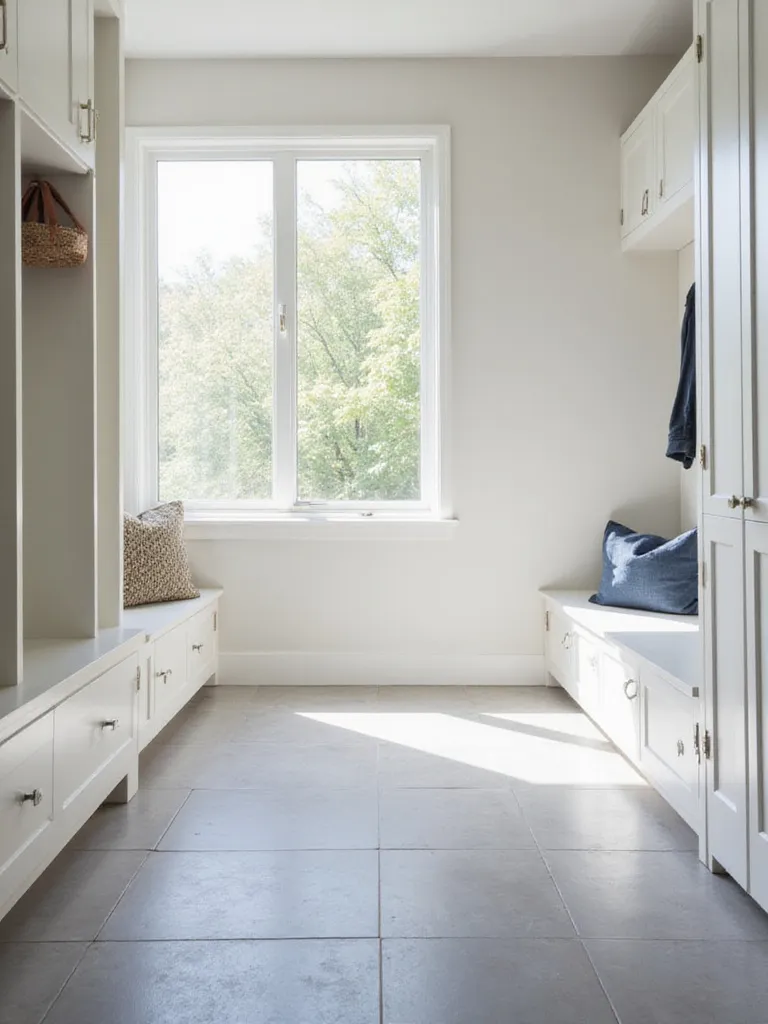
When considering large format tiles for your mudroom, size and material selection require thoughtful consideration. While “large format” typically starts around 12×24 inches and extends to 24×48 inches or larger, the ideal size depends on your room dimensions. Avoid disproportionately large tiles in small spaces, which can appear awkward and increase installation waste. Porcelain emerges as an excellent material choice, offering inherent durability and moisture resistance that perfectly complements the benefits of minimal grout lines. Ceramic provides more budget-friendly options, while natural stone brings luxury – though with additional maintenance requirements.
The tricky part is that while large format tiles reduce cleaning challenges, safety concerns in wet mudrooms demand attention to texture and slip resistance.
In mudrooms where moisture constantly threatens, safety underfoot becomes non-negotiable. Textured tiles specifically enhance grip and minimize slip risks, making them ideal for wet mudroom environments. Several texture types excel at preventing slips: slip-resistant finishes (look for coefficient of friction ratings of 0.6+), physically textured surfaces (embossed, hammered, or cleft), aggregated surfaces with embedded particles like quartz, and rocker or riven finishes mimicking natural stone. Each creates more contact points for shoes, dramatically improving traction when wet.
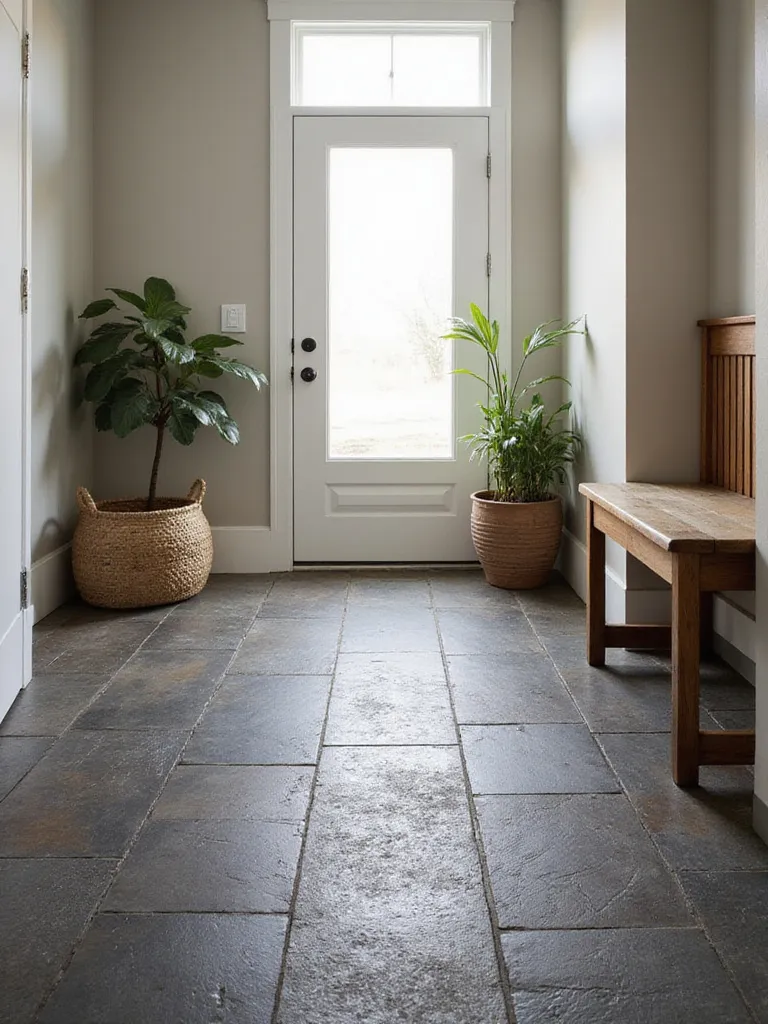
While textured tiles prioritize safety, many homeowners wonder about cleaning challenges. Yes, textured surfaces require slightly more effort than perfectly smooth tiles, as texture can trap dirt in crevices. However, the safety benefits generally outweigh this minor inconvenience. Stiff-bristled brushes or grout brushes help reach into textured depths. Quality tile cleaners designed for your specific tile type protect surfaces while cleaning effectively. Avoid harsh chemicals or abrasives that might damage tiles or grout. Pre-sealing grout significantly simplifies cleaning by preventing deep dirt embedding.
What many people overlook is that grout color selection dramatically impacts mudroom maintenance. Dark grout offers particular advantages worth considering.
In high-traffic mudrooms where dirt inevitably accumulates, dark grout emerges as a practical design choice with outsized benefits. Its primary advantage? Remarkable ability to camouflage dirt, mud, and stains that constantly enter these busy spaces. Unlike light-colored grout that quickly discolors and demands frequent scrubbing, dark grout maintains a cleaner appearance significantly longer, dramatically reducing maintenance needs. This proves especially valuable in households with children, pets, or active lifestyles where mud and dirt arrive daily. Dark grout lets you spend less time cleaning and more time enjoying a tidier-looking mudroom.

“Dark grout” encompasses various shades that effectively conceal dirt while complementing different flooring styles. Options include grays (from charcoal to slate), browns (chocolate, espresso, taupe), and classic black. The best pairing materials either create striking contrast or harmonious complementary aesthetics. Light-colored tiles (white, cream, light gray) create bold contrast that accentuates tile shapes while hiding dirt. Natural stone with inherent color variations works beautifully with dark grout, which unifies the overall look while connecting different stone tones. Consider porcelain, ceramic, or vinyl tiles that realistically mimic stone or wood – all enhanced by dark grout’s practical benefits.
Do you see how huge that is? While grout color affects maintenance, patterned tiles can transform mudroom flooring from purely functional to genuinely eye-catching.
Looking beyond purely functional mudroom flooring? Patterned tiles inject instant personality and distinctive style. These design powerhouses elevate aesthetics in spaces often dominated by practicality. Their patterns effectively camouflage dirt, scuffs, and everyday wear, maintaining cleaner appearances between cleanings. They provide durable, water-resistant surfaces essential for mudroom demands while visually defining spaces within open floor plans or creating striking focal points that transform utilitarian entryways into design statements.

“Patterned tiles turn mundane mudrooms into memorable spaces. They’re not just functional – they’re conversation starters that set the tone for your entire home.” – Riley Thompson, Music Room Design Specialist
The patterned tile universe offers endless possibilities, but certain styles particularly suit mudroom applications. Geometric patterns (chevrons, hexagons, Moroccan-inspired designs) provide visual dynamism while hiding dirt effectively. Floral or botanical patterns introduce nature’s softness, balancing mudroom hardness. Match patterns to your home’s overall style – traditional homes complement classic encaustic-look tiles, while modern spaces embrace bold geometrics. Generally avoid very light or overly intricate patterns that show dirt more readily. Consider larger patterns for smaller mudrooms to create spaciousness without overwhelming busyness.
This changes everything, doesn’t it? While beautiful patterns elevate mudroom aesthetics, comfort becomes paramount in colder climates – making radiant heated flooring worth serious consideration.
Imagine stepping into your mudroom on frigid winter days and feeling gentle warmth radiating through your feet. Radiant heated flooring transforms utilitarian mudrooms into luxurious transition spaces. The benefits extend far beyond comfort – though that alone justifies consideration. This system provides unparalleled coziness during cold months, especially welcome after braving outdoor elements. Beyond comfort, radiant heat actively dries wet shoes, boots, and damp pet paws, preventing moisture buildup and potential mold growth. It contributes to overall energy efficiency through consistent, even heat distribution that may reduce central heating dependence. As a bonus, radiant systems eliminate bulky radiators or vents, freeing valuable wall space and creating cleaner aesthetics.
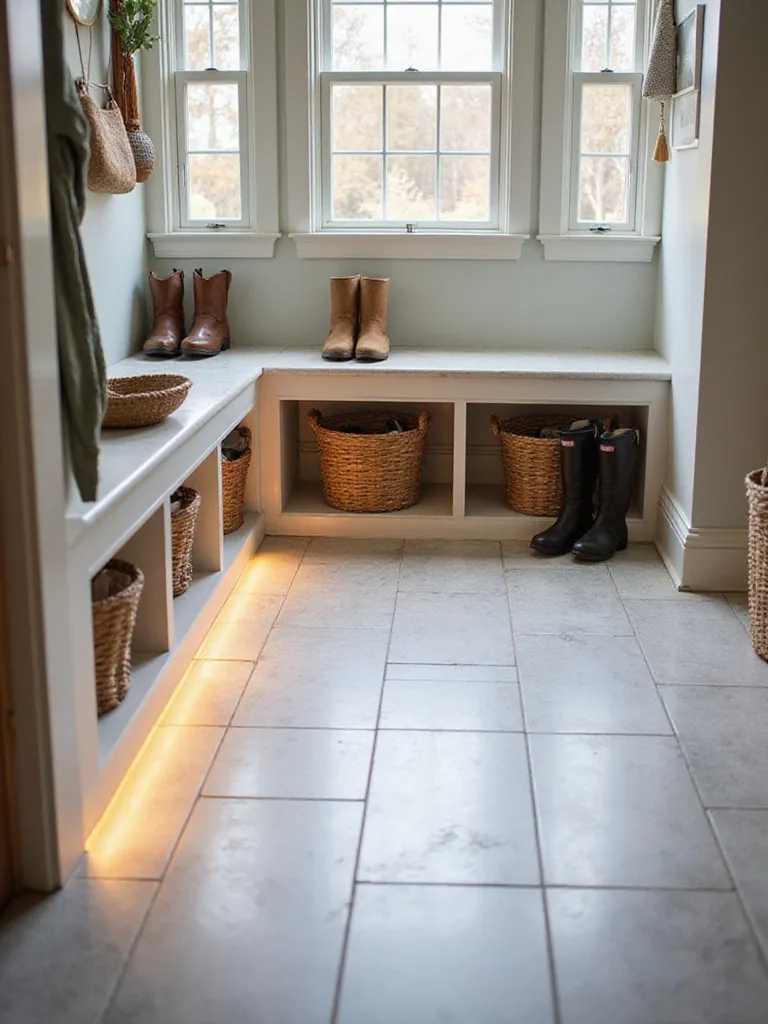
When considering radiant heated mudroom flooring, you’ll choose between electric and hydronic systems. Electric systems use cables or mats embedded within flooring to generate heat. They install more easily, especially in smaller mudrooms, making them popular for retrofit projects, and offer responsive temperature control. Hydronic systems circulate heated water through subfloor pipes. While more complex to install, they typically provide greater energy efficiency for larger areas, worth considering for whole-house radiant heating. For mudrooms specifically, electric systems generally win for straightforward installation and suitability for smaller spaces. Within electric options, pre-formed mats offer quicker, more consistent heating, while loose cables provide greater layout flexibility but require more precise placement.
The game-changer happened as homeowners realized that beyond comfort, safety requires specific attention to slip resistance in mudroom flooring choices.
Safety isn’t optional in mudrooms – it’s essential. Slip resistance becomes particularly critical in these moisture-prone transition spaces. Mudrooms naturally encounter water from rain, snow, mud, and occasional spills, creating significant fall hazards, especially for children, seniors, and pets. Choosing slip-resistant mudroom flooring proactively minimizes these risks, creating safer environments for everyone in your household.
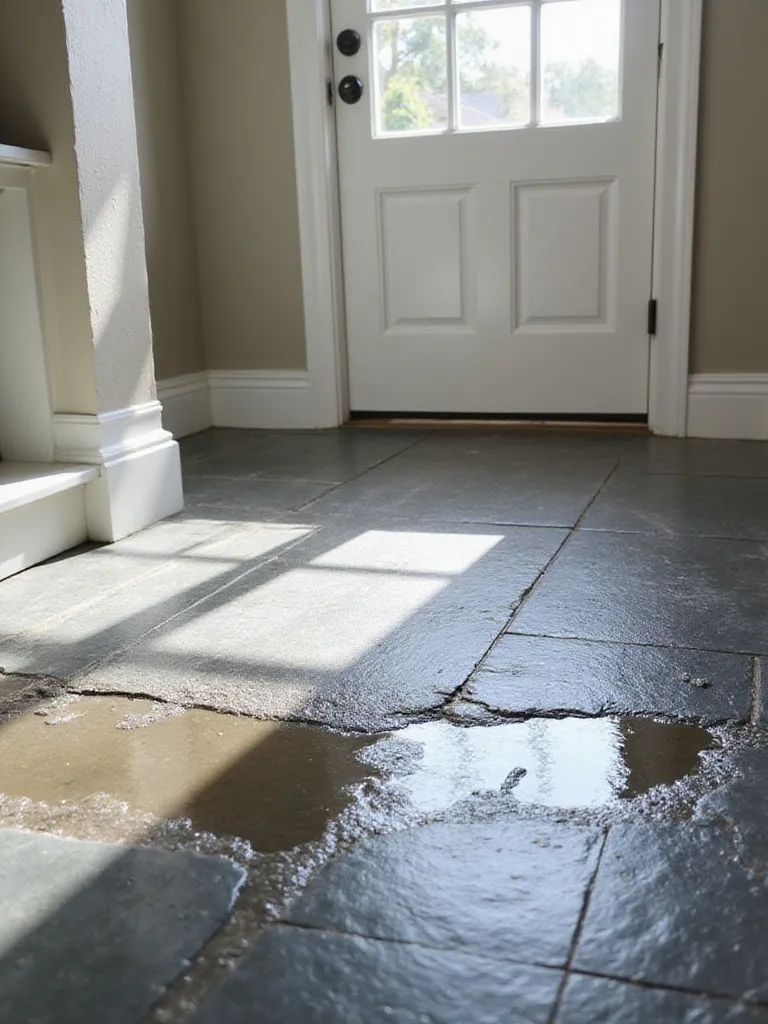
Several flooring materials excel in providing slip resistance without sacrificing style. Textured porcelain or ceramic tile combines durability and water resistance with inherent grip, especially when specified with slip-resistant finishes. Natural stone like slate or travertine, particularly with honed or textured surfaces rather than polished ones, provides excellent traction. Luxury Vinyl Plank (LVP) and Luxury Vinyl Tile (LVT) with embossed surfaces enhance grip while mimicking wood or stone textures. Rubber flooring represents the gold standard for slip resistance, making it exceptionally safe for high-moisture areas. Generally avoid smooth, polished surfaces like high-gloss ceramic or polished concrete, which become dangerously slippery when wet.
My experience went like this: beyond safety, understanding durability ratings became essential for selecting mudroom flooring that truly performs over time.
Durability isn’t just marketing jargon – it’s a critical performance characteristic directly impacting your mudroom flooring’s longevity and appearance. Understanding specific durability ratings empowers informed choices for this high-demand space. For tile, the Porcelain Enamel Institute (PEI) rating measures surface abrasion resistance; mudrooms require PEI 3+ to handle moderate-to-heavy foot traffic. Vinyl flooring durability hinges on wear layer thickness; look for 12+ mil for mudrooms to resist scratches and scuffs. Wood flooring’s Janka hardness rating quantifies dent resistance; higher ratings indicate harder, more durable species. Slip resistance ratings (Coefficient of Friction) remain crucial for safety in moisture-prone mudrooms.
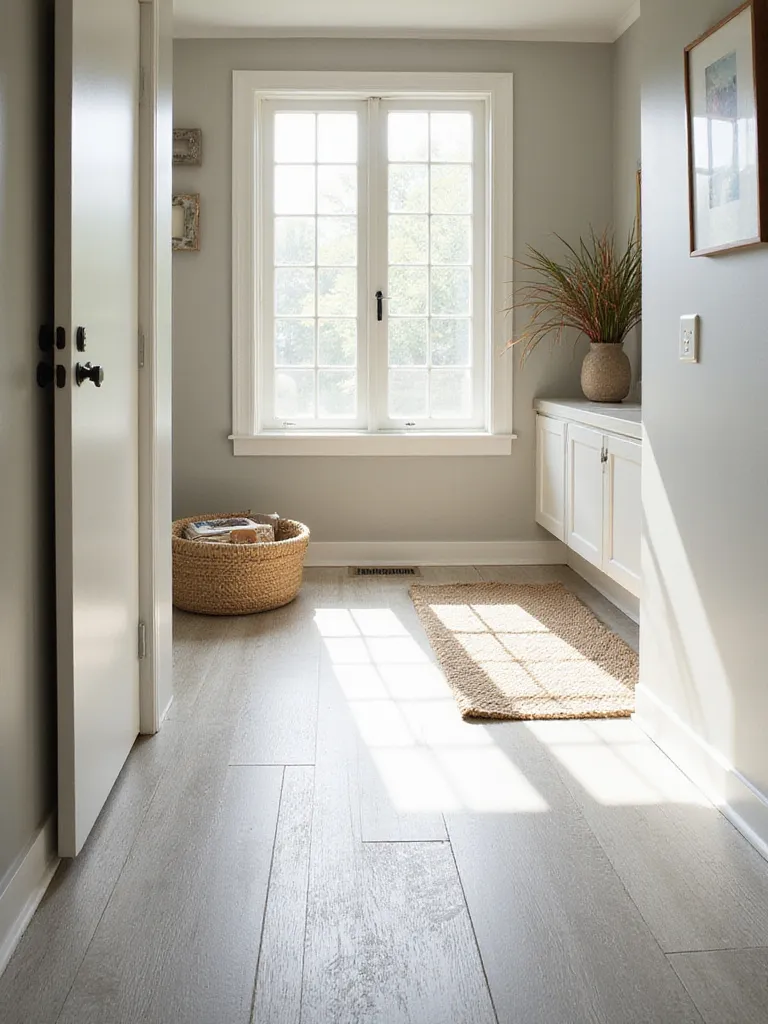
The PEI rating directly indicates tile’s ability to resist surface wear in mudroom environments. PEI 1 suits wall applications only – too delicate for floors. PEI 2 works for very light residential traffic but proves inadequate for mudrooms. For typical mudrooms experiencing moderate-to-heavy foot traffic, target PEI 3, 4, or 5. PEI 3 handles moderate traffic like residential kitchens and hallways. PEI 4 withstands moderate-to-heavy traffic in residential and commercial settings. PEI 5 endures heavy commercial use. Choosing inadequate PEI ratings inevitably leads to premature wear, scratching, and dullness, significantly shortening your mudroom flooring’s lifespan and diminishing its appearance.
Here’s the inside story: beyond durability, busy households crave easy-clean surfaces that minimize maintenance time and maximize mudroom functionality.
In today’s hectic households, easy-clean mudroom flooring isn’t luxury – it’s sanity-saving necessity. What defines “easy-clean” mudroom flooring? These surfaces resist stains, repel dirt, and minimize moisture absorption while requiring minimal cleaning effort. This functionality proves vital in mudrooms – your home’s primary entry point bearing the brunt of heavy traffic, muddy shoes, wet umbrellas, and pet messes. Easy-clean flooring saves precious time and prevents dirt, grime, and bacteria buildup, maintaining more hygienic, attractive spaces for families and guests.
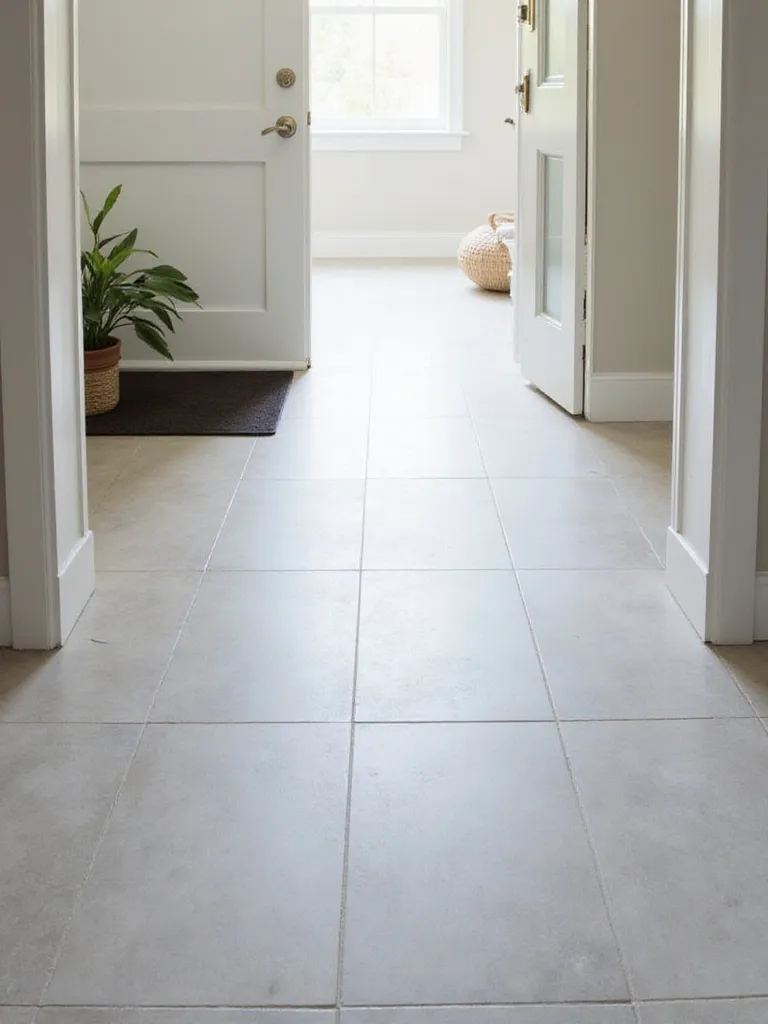
Several flooring materials stand out for exceptional cleaning ease. Porcelain tile tops the list with its virtually non-porous nature, inherent stain resistance, and remarkable durability. Luxury Vinyl Tile (LVT) and Luxury Vinyl Plank (LVP) offer water resistance and realistic aesthetics with minimal maintenance – typically just sweeping and damp mopping. Epoxy flooring creates smooth, non-porous surfaces that wipe clean effortlessly. Natural stone, properly sealed with quality penetrating sealant, becomes relatively easy-care, though maintenance requirements vary by stone type and sealant quality.
Perhaps you’ve already guessed that beyond practical considerations, aesthetic harmony between mudroom flooring and your home’s overall design creates more cohesive, welcoming spaces.
While mudroom functionality remains paramount, style integration shouldn’t be sacrificed. Seamless coordination with your home’s broader aesthetic creates cohesive, welcoming entryways. Why does this matter? Your mudroom serves as vital transition space bridging outdoors and main living areas. Flooring that harmonizes with established style creates visually pleasing flow from the moment you enter. It prevents the mudroom from feeling disjointed and enhances your home’s perceived value and design integrity. Conversely, flooring that clashes disrupts visual harmony, making mudrooms feel awkward and uninviting.
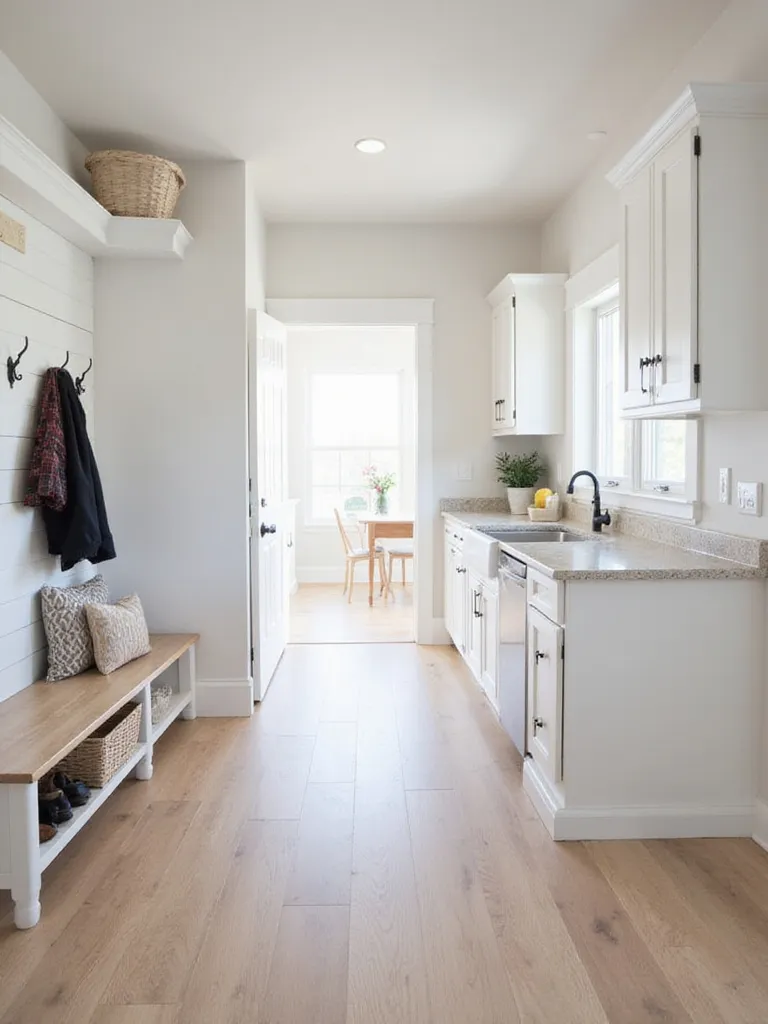
Achieving seamless integration starts with accurately identifying your home’s existing aesthetic. Step back and observe architectural features, color palettes, and dominant furnishings. Is your style primarily modern, traditional, farmhouse, coastal, bohemian, or blended? Note recurring elements like wood types in furniture and trim, metal finishes on hardware, and consistent patterns in textiles. Architectural details in trim, doors, and windows often provide strong style clues. If uncertain, browse design websites, magazines, and social media for inspiration. Identify styles resonating with your existing decor and note common flooring materials, colors, and textures in those aesthetics.
My breakthrough came when I realized that even perfect flooring selection requires proper installation consideration – DIY or professional approaches dramatically affect outcomes.
Selecting perfect mudroom flooring leads to crucial installation decisions: DIY or professional? This choice demands careful consideration of skills, time, and budget to ensure lasting results. Honestly assess your skill level and prior flooring installation experience. Certain materials (intricate tile patterns, large format tiles, epoxy) require specialized skills and tools best left to professionals. Realistically evaluate time commitments – DIY installations typically take significantly longer than professional work, potentially disrupting household routines. Factor in potential tool and material costs beyond basic flooring expenses. Unexpected tool purchases, material waste from errors, or specialized equipment rentals quickly inflate DIY budgets. Consider subfloor condition and complexity – uneven, damaged, or improperly prepared subfloors cause significant problems later; proper preparation often requires professional experience and equipment. Finally, weigh warranties and peace of mind – professional installations typically include material and workmanship warranties, providing valuable investment protection.

Professional installation offers compelling benefits that often justify higher costs, especially for flawless, hassle-free mudroom flooring. Professionals bring extensive subfloor preparation expertise, ensuring level, stable foundations crucial for flooring longevity. They possess specialized tools for precise cuts, consistent spacing, and secure installation, minimizing waste and maximizing quality. Professionals work efficiently, completing installations faster while minimizing home disruptions. Experienced installers navigate unforeseen challenges – from unexpected subfloor issues to tricky transitions or custom cuts. Perhaps most importantly, professional work typically includes warranties against material and workmanship defects, providing significant peace of mind for your investment.
Everything changed after I realized that smart budgeting strategies could deliver exceptional mudroom flooring without breaking the bank.
Mudroom renovations don’t require financial strain. Smart budgeting delivers beautiful, durable floors without excessive spending. The most cost-effective options that maintain quality include vinyl flooring – particularly luxury vinyl plank (LVP) or luxury vinyl tile (LVT) – which balances water resistance, scratch resistance, and reasonable costs. Sheet vinyl provides even greater budget-friendliness, though LVP/LVT typically offer better durability and style range. Ceramic tile delivers classic durability at moderate prices. For modern minimalism on budgets, consider concrete flooring – stained and sealed for style at lower costs than many alternatives. Generally avoid expensive, high-maintenance options like solid hardwood or natural stone unless you find remnants, discounted lots, or can allocate significant portions of your budget.
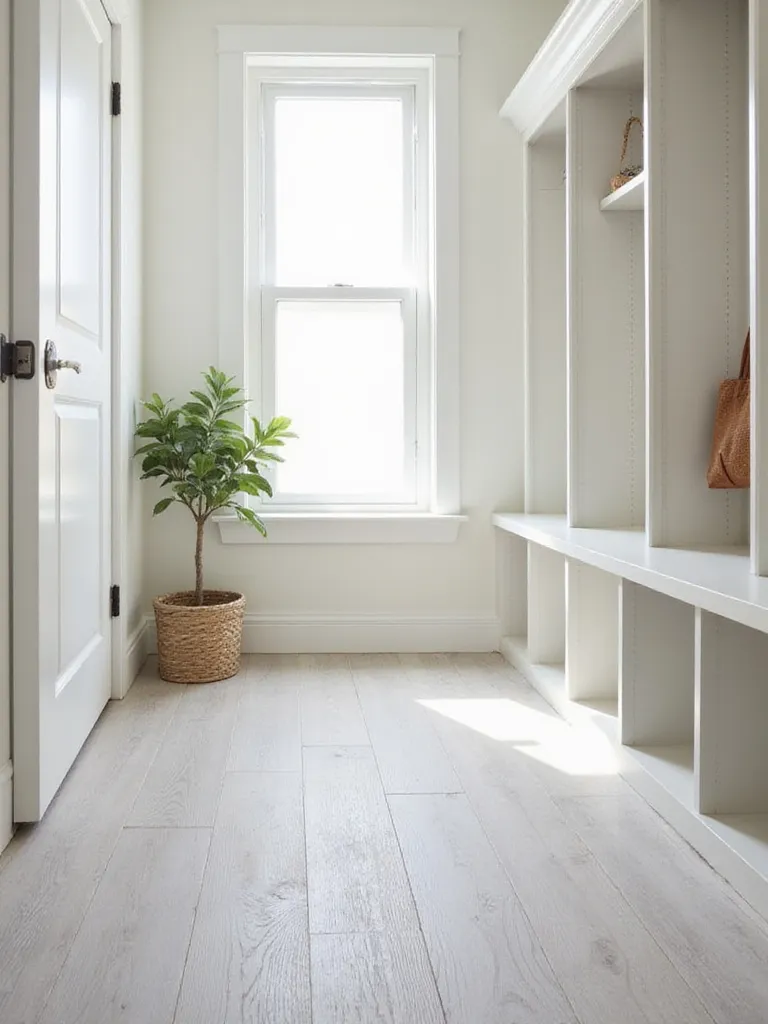
Installation costs significantly impact overall mudroom flooring expenses. DIY installation directly reduces these costs, particularly with relatively accessible materials like click-lock vinyl plank or smaller format tiles. Sheet vinyl installation presents greater challenges for beginners due to size and adhesive requirements. If choosing professional installation, obtain multiple detailed quotes comparing not just bottom-line prices but specific work scopes and included materials. Consider handling preparatory work yourself – removing old flooring, cleaning subfloors, or transporting materials – to potentially reduce labor costs while maintaining professional installation quality.
Choosing the right mudroom flooring balances practicality, style, and budget considerations. Whether you prioritize indestructible durability with porcelain tile, crave wood’s warmth without worry through luxury vinyl, desire natural stone’s timeless elegance, or need budget-friendly solutions that still perform beautifully – the perfect mudroom flooring exists for your specific needs.
Remember that your mudroom serves as both functional workhorse and welcoming introduction to your home. The flooring you select sets the foundation for this crucial transition space. By carefully weighing durability requirements, moisture exposure, maintenance preferences, aesthetic goals, and budget constraints, you’ll create a mudroom that not only stands up to daily demands but also welcomes you home in style for years to come.